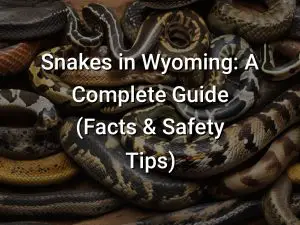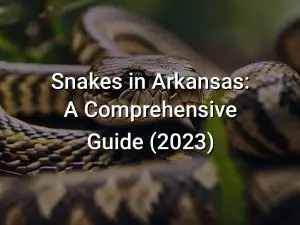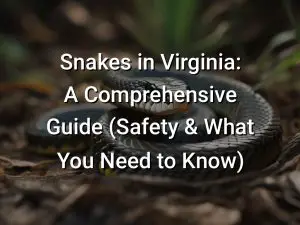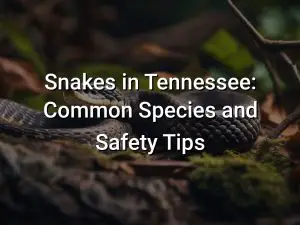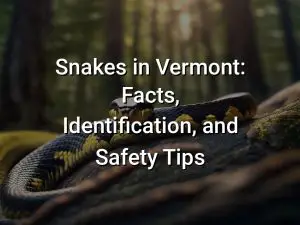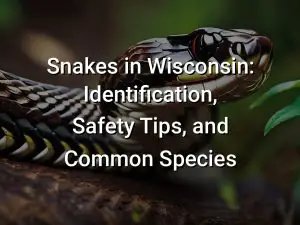Snakes in Kansas: A Comprehensive Guide (Safety & Identification)
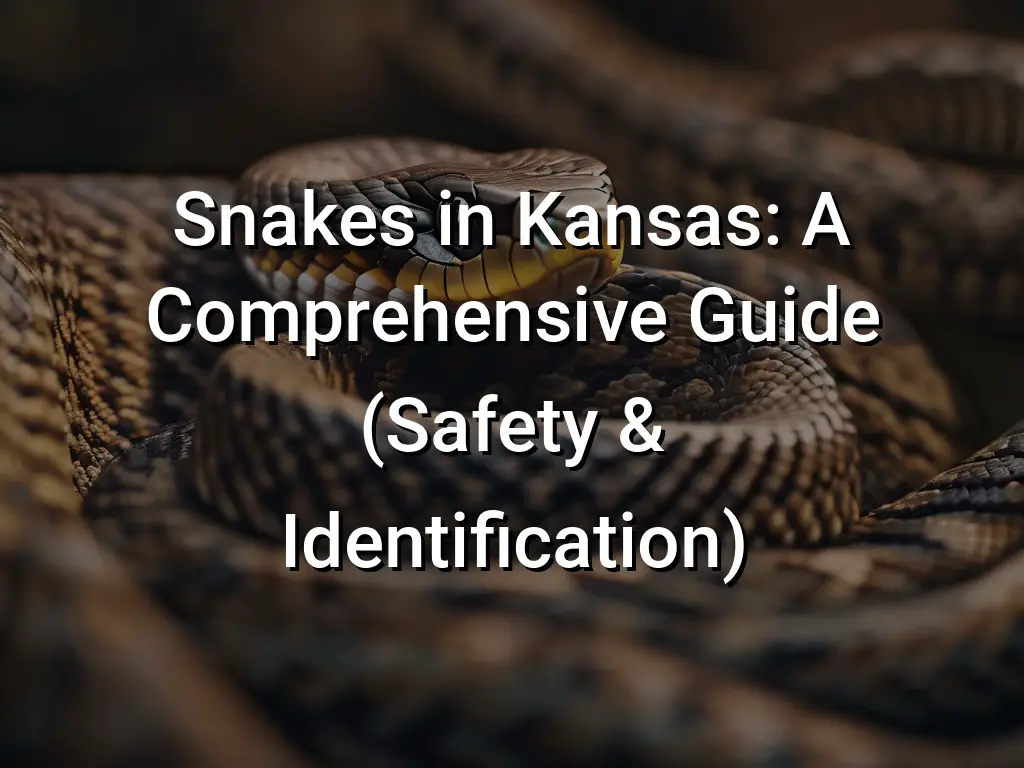
Are you curious about the snakes that call Kansas home? Whether you have a fear of snakes or a fascination for these slithering creatures, this comprehensive guide is here to provide you with all the information you need to know. From the different types of snakes found in Kansas to safety precautions and conservation efforts, we’ve got you covered.
Throughout this guide, we’ll explore the various types of snakes that inhabit Kansas, including their identification, habitat, and behavior. We’ll also provide safety tips to help you avoid snake bites, as well as snakebite first aid in case of an emergency. Additionally, we’ll discuss the ongoing conservation efforts aimed at preserving these reptiles and debunk common misconceptions about snakes. Whether you’re looking for educational resources or advice on snake removal and prevention, this guide has everything you need to navigate the world of snakes in Kansas.
Quick Links
Types of Snakes in Kansas
Kansas is home to a diverse range of snake species, each with its own unique characteristics and habitats. Here are some of the most commonly found snakes in Kansas:
- The Eastern Garter Snake: This non-venomous snake is characterized by its long and slender body, with distinctive yellow stripes running down its dark-colored back. Eastern Garter Snakes are commonly found in a variety of habitats, including grasslands, woodlands, and wetlands.
- The Bullsnake: Also known as the gopher snake, the Bullsnake is one of the largest snake species in Kansas. It has a robust body and can reach lengths of up to 6 feet. Bullsnakes are non-venomous and are often mistaken for rattlesnakes due to their similar appearance.
- The Western Rat Snake: This species, also known as the Black Rat Snake, is a constrictor that primarily feeds on rodents. It has a glossy black color, sometimes with white or yellow markings. Western Rat Snakes are typically found in grasslands, farmlands, and wooded areas.
- The Western Diamondback Rattlesnake: This venomous snake is recognizable by the distinctive diamond-shaped markings on its back and the rattle at the end of its tail. Western Diamondback Rattlesnakes are found in rocky or desert habitats in western Kansas and should be approached with caution.
- The Copperhead: This venomous snake has a distinctive copper-colored head, which gives it its name. Copperheads are predominantly found in eastern and southeastern Kansas and prefer wooded or swampy areas. They are usually not aggressive but can deliver a painful bite if threatened.
It’s important to remember that while some snakes in Kansas may be venomous, most are harmless and play an important role in the ecosystem. If you encounter a snake, it is best to observe it from a safe distance and avoid disturbing it.
Identification of Venomous Snakes
When encountering snakes in Kansas, it’s essential to be able to identify the venomous species to ensure your safety. Although the majority of snakes in Kansas are harmless and play a crucial role in the ecosystem, there are a few venomous species to be aware of.
The three venomous snake species found in Kansas are:
- Rattlesnakes: The most well-known venomous snakes, they have a distinct rattle at the end of their tails. They can be identified by their triangular-shaped heads and vertical pupils.
- Copperheads: These snakes have a distinctive copper-colored head and hourglass-shaped bands on their bodies. They are commonly found in wooded areas or near bodies of water.
- Cottonmouths (also known as Water Moccasins): Found primarily in the southeastern parts of Kansas, they have a dark, almost black, body with white or pale-colored bands. They are often found near water sources.
It is important to remember that not all snakes in Kansas are venomous, and most snake bites occur when people try to handle or provoke the snake. It is always best to keep a safe distance and observe snakes from afar.
If you encounter a snake and are unsure of its species, it is recommended to leave it alone and contact local authorities or snake experts for assistance in identification and removal if necessary.
Safety Precautions
When encountering snakes in Kansas, it is important to take certain safety precautions to avoid any potential risks. Here are some key safety measures to keep in mind:
- Stay Alert: When in snake habitats such as grasslands, woodlands, or near water sources, always be aware of your surroundings and watch where you step or place your hands.
- Wear Appropriate Clothing: If you are venturing into areas with high snake activity, consider wearing long pants, closed-toe shoes, and tall boots to minimize the risk of snake bites on your legs or feet.
- Use a Walking Stick: Carrying a walking stick or hiking pole can help you gently probe the ground ahead of you to detect any hidden snakes and give them a chance to move away.
- Keep Your Distance: If you encounter a snake, maintain a safe distance of at least several feet and do not try to handle or provoke it. Most snake bites occur when people attempt to capture or kill snakes.
- Know the Signs: Familiarize yourself with the common visual and auditory signs of snake presence, such as warning postures, hissing sounds, or the presence of shed snake skins. This can help you identify potential snake habitats and take appropriate precautions.
- Stay on Designated Trails: Stick to established paths and trails, as they are generally clear of snake hiding spots. Avoid tall grasses, dense vegetation, and rocky areas where snakes may seek shelter.
- Teach Children About Snake Safety: Educate children about the importance of snake safety, including staying away from snakes, not touching them, and alerting an adult if they spot a snake.
- Keep Your Outdoor Spaces Neat: If you live in an area with snake sightings, make sure to keep your yard tidy, clearing away brush, debris, and potential snake hiding spots. Regular yard maintenance can help discourage snakes from seeking shelter on your property.
By following these safety precautions, you can minimize the risk of snake encounters and keep both yourself and the snakes safe.
Habitat and Behavior
Snakes in Kansas inhabit a variety of habitats, from grasslands and forests to wetlands and rocky areas. They can be found in both rural and urban areas, although they are more commonly encountered in rural regions with more natural habitats.
Snakes are ectothermic animals, meaning they rely on external sources of heat to regulate their body temperature. This makes them more active during warmer months and less active during colder periods. They are most active during the day, especially in the early morning and late afternoon when temperatures are more moderate.
Most snakes in Kansas are non-venomous and pose no threat to humans. They primarily feed on small mammals, birds, eggs, and other reptiles. They play a crucial role in controlling rodent populations and maintaining the balance of local ecosystems.
It’s important to remember that snakes are generally more afraid of humans than humans are of them. They will typically try to avoid confrontations and will only bite when threatened or provoked. If you encounter a snake, it’s best to keep your distance and give it space to retreat.
Snakes in Kansas are an integral part of the state’s biodiversity and should be respected and protected. By understanding their habitat and behavior, we can coexist with these fascinating creatures and appreciate the important role they play in the natural world.
Snakebite First Aid
In the unfortunate event of a snakebite, it is important to take immediate action to minimize the effects and seek medical help as soon as possible. Follow these steps for snakebite first aid:
- Stay calm and try to remember the snake’s appearance. This will help medical professionals identify the snake and provide the appropriate treatment.
- Keep the victim still and in a safe place to prevent the venom from spreading more quickly through the body.
- Remove any tight clothing or jewelry near the bite area as swelling may occur.
- Clean the bite wound gently with mild soap and water.
- Apply a clean, sterile bandage or cloth to the wound to minimize the risk of infection.
- Elevate the affected limb below heart level if possible, to slow the spread of venom.
- Avoid applying a tourniquet or attempting to suck out the venom, as these outdated methods can do more harm than good.
- Call emergency services or go to the nearest hospital immediately for professional medical treatment.
Remember, snakebite first aid is not a substitute for proper medical care. It is crucial to seek professional help as soon as possible, as snakebites can have serious consequences if not treated promptly and appropriately.
Conservation Efforts
Conservation efforts play a crucial role in protecting and preserving the snake populations in Kansas. Many organizations and individuals are dedicated to studying and conserving these unique creatures. Here are some of the key conservation efforts taking place:
- Habitat Conservation: Protecting and conserving the natural habitats where snakes reside is essential for their survival. Efforts are made to preserve and restore the diverse ecosystems, such as wetlands, grasslands, and forests, that provide essential resources and shelter for snakes.
- Research and Monitoring: Organizations conduct research and monitoring programs to understand snake populations, their distributions, and behaviors. This information helps guide conservation strategies and ensure effective protection measures are in place.
- Public Education: Raising awareness among the public about the importance of snakes in the ecosystem and dispelling common misconceptions is crucial for their conservation. Educational campaigns, workshops, and outreach programs aim to promote coexistence and respect for these reptiles.
- Snake Rehabilitation: In cases where snakes are injured or displaced, rehabilitation centers provide care and treatment, aiming to release them back into their natural habitats. These facilities not only help individual snakes but also contribute to broader conservation efforts.
- Policy and Legislation: Advocacy for protective measures, such as regulations and laws against the illegal collection and trade of Kansas snakes, helps safeguard their populations. Collaborations between government agencies, wildlife officials, and conservation organizations work towards ensuring their welfare.
By supporting these conservation efforts, individuals can contribute to the preservation of snake species in Kansas and promote a balanced and healthy ecosystem.
Common Misconceptions
Despite their reputation, snakes in Kansas are often misunderstood. Here are some common misconceptions about snakes that need to be cleared up:
- “All snakes are venomous.” This is far from true. In fact, out of the 38 species of snakes recorded in Kansas, only five are venomous. It’s important to remember that the majority of snakes are harmless and play a crucial role in the ecosystem.
- “Snakes are aggressive and will attack humans.” Snakes are generally shy and prefer to avoid human encounters. They will usually retreat or hide when they sense humans nearby. Bites usually occur when snakes feel threatened or are accidentally provoked.
- “You can identify a venomous snake by its color.” This is a common misconception. The color of a snake is not a reliable indicator of its venomous or non-venomous nature. Venomous snakes can have a variety of colors and patterns, just like non-venomous snakes.
- “You can tell if a snake is venomous by the shape of its head.” While it’s true that venomous snakes typically have triangular-shaped heads, this is not always a foolproof method of identification. Some non-venomous snakes can also flatten their heads when feeling threatened, leading to potential confusion.
- “Snakes are slimy.” Snakes may appear to be slimy due to their smooth scales, but they are not actually slimy. Their scales are dry and smooth to help them move efficiently across various terrains.
By debunking these misconceptions and educating ourselves about snakes, we can foster a better understanding and appreciation for these fascinating creatures and coexist with them safely.
Snake Removal and Prevention
Encountering a snake in your home or property can be a frightening experience. Here are some steps you can take to safely remove snakes and prevent future encounters:
- Stay calm: It’s important to remain calm if you come across a snake. Most snakes in Kansas are non-venomous and pose little threat to humans.
- Identify the snake: Before attempting to remove a snake, try to identify its species. This will help determine whether it is venomous or harmless.
- Call a professional: If you are unsure about the type of snake or uncomfortable handling it, it’s best to contact a professional snake removal service. They have the expertise and equipment to safely remove snakes from your property.
- Remove potential habitats: Snakes are attracted to areas with ample food and shelter. Keep your property clean and tidy, removing any potential hiding spots such as piles of wood, debris, or overgrown vegetation.
- Seal entry points: Inspect your home for any gaps or openings that snakes could use to gain access. Seal these entry points to prevent snakes from entering your house.
- Trim vegetation: Keep the grass mowed and trim shrubs and bushes regularly. This reduces the potential hiding spots for snakes and makes your property less attractive to them.
- Remove food sources: Snakes feed on rodents, insects, and small animals. By controlling pests on your property, you can eliminate a potential food source for snakes.
- Install snake-proof fencing: If you live in an area with a high snake population, consider installing snake-proof fencing around your property. This can help keep snakes out and provide peace of mind.
- Be vigilant: Regularly inspect your property for signs of snakes, such as shed skins or droppings. If you spot a snake, take appropriate precautions and follow the steps outlined above.
By following these guidelines, you can minimize the chances of encountering snakes and create a safer environment for yourself and your family.
Educational Resources
Learning about snakes in Kansas can be an exciting and educational experience. Fortunately, there are several resources available that can help you expand your knowledge and understanding of these fascinating creatures. Whether you’re interested in snake identification, habitat information, or safety tips, these educational resources can provide valuable information:
- Kansas Department of Wildlife, Parks and Tourism: The official website of the Kansas Department of Wildlife, Parks and Tourism offers a wealth of information about snakes and other wildlife in the state. You can find detailed species profiles, conservation efforts, and safety guidelines.
- Kansas State University Extension: The extension program at Kansas State University provides educational resources on various topics, including snakes in Kansas. They offer fact sheets, articles, and workshops that cover snake identification, behavior, and habitat management.
- Local Nature Centers and Museums: Many local nature centers and museums in Kansas have exhibits and educational programs focused on snakes and other reptiles. These institutions often offer guided tours, workshops, and interactive displays that can help you learn more about local snake species.
- Snake Identification Guides: There are several field guides and books available that specifically focus on snake identification in Kansas. These guides typically include detailed descriptions, photographs, and distribution maps to help you accurately identify different snake species in the state.
- Online Communities and Forums: Engaging with online communities and forums dedicated to snake enthusiasts can be a great way to learn from experienced snake lovers. These communities often share knowledge, personal experiences, and resources that can enhance your understanding of snakes in Kansas.
By utilizing these educational resources, you can deepen your knowledge and appreciation for snakes in Kansas while ensuring your safety and the preservation of their habitats.
Snake-Friendly Landscaping
Creating a snake-friendly landscape can help foster a harmonious coexistence with these reptiles while also ensuring the safety of your family and pets. Here are some tips for landscaping your property with snakes in mind:
- Provide natural shelter: Incorporate natural features in your landscaping design that can serve as shelter for snakes, such as rock piles, fallen logs, and dense vegetation. These areas can provide snakes with hiding spots and encourage them to stay away from high-traffic areas.
- Keep a well-maintained yard: Regularly mow your lawn, trim back overgrown shrubs, and remove any clutter or debris. Snakes are less likely to take up residence in a tidy and open space.
- Plant native vegetation: Choose native plants and shrubs for your garden, as they can attract natural prey for snakes, such as rodents and insects. This can help create a balanced ecosystem and decrease the chances of issues with snakes.
- Consider a snake-proof fence: If you’re particularly concerned about snakes entering your property, you may want to invest in a snake-proof fence. These fences are specifically designed to prevent snakes from slithering through.
- Remove potential food sources: Snakes are attracted to areas where they can find a readily available food source. By minimizing attracting wildlife, such as bird feeders or pet food left outdoors, you can reduce the likelihood of snakes setting up camp in your yard.
- Minimize water sources: Snakes need water to survive, so be mindful of minimizing potential water sources in your yard, such as leaky faucets or standing water. Removing these sources can discourage snakes from staying in your area.
Remember, snakes play an important role in our ecosystem, helping to control rodent populations and maintain a balanced environment. By making your landscaping snake-friendly, you can promote coexistence and appreciation for these fascinating creatures.
Conclusion
As you can see, snakes in Kansas are a diverse group with various species, some of which are venomous. It’s crucial to be able to identify venomous snakes and take necessary safety precautions when encountering them in their natural habitat.
If you come across a snake, it’s best to leave it alone and observe from a safe distance. In the event of a snakebite, quick action and proper first aid can be life-saving. Additionally, implementing snake removal and prevention methods, as well as creating snake-friendly landscaping, can help mitigate conflicts between humans and snakes.
By educating yourself about snakes in Kansas and promoting conservation efforts, you can develop a better understanding and appreciation for these often misunderstood creatures. Remember, snakes play important roles in our ecosystem, and with the right knowledge and precautions, we can coexist with them safely.
Stay curious, stay cautious, and continue to explore and appreciate the fascinating world of snakes in Kansas.

